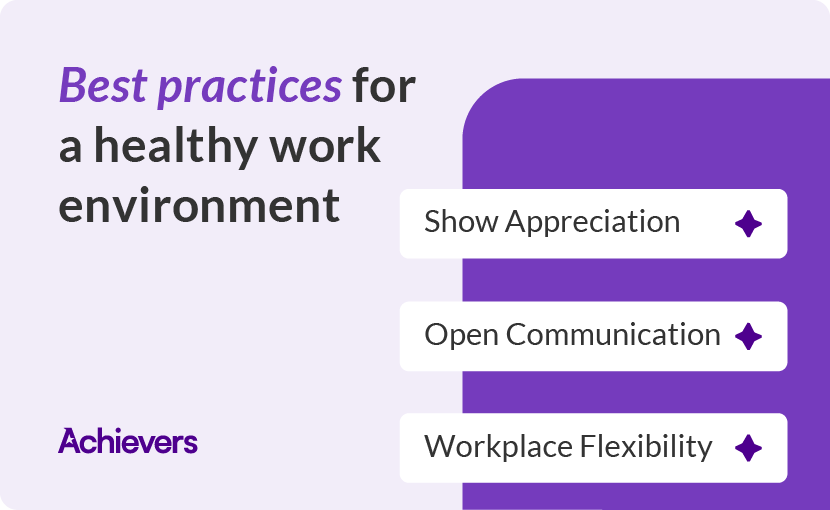Table of contents
What makes a company a great place to work? Is it the perks? The location? Maybe the compensation?
Ultimately, the key to creating and sustaining a high-performing organization is establishing a healthy work environment. Businesses that prioritize long-term success show that they care about their employees, whether their team members are on-site, remote, or part time. But it’s hard to define a healthy work environment, let alone put it into practice — particularly when so many employees are working from home. This piece delves into what a healthy work environment is and outlines 15 steps to get there.
What does a healthy work environment look like?
While some classify work environments into various categories — like creative, social, goal-oriented, and traditional — the best work environments feature the positive elements of all these types. A fantastic work environment celebrates innovation and individuality. It encourages collaboration and teamwork while providing employees with the flexibility and autonomy they need to reach their personal goals.
Healthy work environments are also safe, both psychologically and physically. Organizations with great cultures make it a point to support employee wellness and accept all backgrounds. Their leaders are transparent about why decisions are made, and they recognize employees who live out company values each day.
What is a key requirement for a healthy work environment?
A key requirement for a healthy work environment is fostering a culture of trust and psychological safety, where employees feel comfortable expressing themselves, sharing ideas, and providing feedback without fear of judgment or repercussion.
How do you create a healthy work environment?
You can create a healthy work environment by following these best practices:
- Prioritizing open communication channels to encourage feedback and transparency
- Implementing policies that promote work-life balance and employee well-being
- Promoting a culture of respect and inclusivity through diversity initiatives
- Providing opportunities for continuous learning and professional growth
- Cultivating a supportive team atmosphere where collaboration and mutual respect thrive
These practices not only enhance employee satisfaction and productivity but also contribute to a positive organizational culture and long-term success.
Why should you develop a healthy work environment?
You should develop a healthy work environment because it directly correlates with increased employee satisfaction, productivity, and retention rates. For example, the Achievers Workforce Institute (AWI) 2024 Engagement and Retention Report shows that 72% of employees would stay longer at a job where they feel cared for and valued vs a job where they don’t but receive a 30% raise. This shows the true value of a healthy work environment.
By prioritizing the well-being of your team, you not only foster a positive workplace culture but also promote physical and mental health, resulting in reduced absenteeism and healthcare costs. Additionally, a healthy work environment cultivates innovation, creativity, and effective teamwork, leading to better business outcomes and long-term success.

15 ways to build a healthy work environment
Creating and maintaining a healthy work environment requires a winning strategy. Here are 15 best practices you can follow to start transforming your organization’s culture for the better.
1. Give your employees a real voice
Feedback from employees is a precious resource, offering insights that can drive organizational success. By providing channels for expression, you empower your team to voice their concerns and ideas, facilitating opportunities for growth and improvement.
Harnessing technology like AI-powered HR chatbots and pulse surveys streamlines this process, enabling real-time dialogue and actionable insights. Transitioning from traditional annual surveys to continuous feedback mechanisms ensures timely responses to issues, fostering a culture of agility and responsiveness within your organization.
However, soliciting feedback is only the first step. Failing to take action on survey results leads to lower engagement than failing to survey in the first place. To show employees that their voices matter — and keep them motivated to share what they really think — encourage managers to create action plans in response to feedback collaboratively with their teams.
Of course, knowing exactly what your team needs to succeed requires a strong culture of feedback. This is especially true when you consider that 80% of employees who have received meaningful feedback in the past week are fully engaged.
2. Show appreciation every day
Think about the last time you got a shout out from your boss when you least expected it. It probably gave you a rush of confidence, instantly boosting your mood. Maybe it even gave you the energy you needed to close out a big project. Frequent, meaningful recognition can dramatically improve employee engagement, retention, and satisfaction. Not surprisingly, recognition is a key part of a healthy work environment.
According to The Belonging Blueprint from AWI, employees who are recognized are 55% more likely to feel a sense of belonging at work, which is a huge part of what drives a healthy work environment. Encourage recognition across your organization, from staff all the way to the C-suite. Recognition should be public so that employees echo and learn from others’ successes, and it should be specific enough to reinforce behaviors that you want employees to repeat.
The fastest way to make recognition a habit is to leverage recognition technology. Organizations without recognition technology are 160% more likely to recognize employees only twice a year or less. By selecting a modern recognition platform, employees can say thanks — or dole out reward points — anytime, anywhere, without interrupting their established workflows.
3. Focus on the workplace itself — even if you’re remote!
If an employee likes their workspace, it can increase motivation, improve well-being, and promote healthy habits. Invest in making your office a more enjoyable place to be, and your employees will love spending time there.
Even if most of your workforce is remote, where they work still affects their performance. Make sure your employees have a comfortable, stimulating place to work outside the office by providing a stipend for things like ergonomic chairs, extra monitors, and standing desks. Ask employees to speak up when they need a new mouse, keyboard, or other office supplies. And remind employees that keeping their desks decluttered, getting enough sunlight, and adding inspiring artwork to their workspace can maximize their productivity and boost their mood.
4. Turn your values into more than just words
No employee wants to work at an organization that lacks compelling values, or one that doesn’t practice what it preaches. Developing and living by meaningful core values drives a great organizational culture and, eventually, profits. Organizations with highly aligned cultures, together with highly aligned innovation strategies, see 30% higher enterprise value growth and 17% higher profit growth. Not only that, but compelling values also attract better candidates. For example, a whopping 54% of employees would take a pay cut to work at a company with better values and 56% wouldn’t even consider a job if they disagree with the company’s values.
Employees look to leadership to establish standards for conducting business, internally and externally. Company values should reflect the underlying philosophy of a business, and they should be easy for all employees to understand and remember. You should also reward and recognize employees who exemplify your company’s core values, which encourages other team members to follow suit.
5. Create an environment of psychological safety and trust
An environment of psychological safety is one where employees are comfortable being themselves. They know they can express themselves freely without the fear of embarrassment or retaliation. When employees are confident their ideas won’t be rejected out of hand or scoffed at, they’re far more likely to participate in meaningful conversations, voice their opinions, and stay engaged.
Establishing a workplace that takes psychological safety seriously requires practice and dedication, but it’s worth it. Employees at high-trust companies are 260% more motivated to work, have 41% lower rates of absenteeism, and are 50% less likely to look for another job.
Psychological safety is built on a foundation of genuine care for the employee. Regularly check in on employees’ mental, physical, and emotional health, and give them the time off they need. Most importantly, teach managers to adopt practices that promote psychological safety.
Workshops can be a great way for managers to practice leading with empathy, giving specific recognition, and phasing out micromanagement. Managers need to listen more than they speak and should invite open and honest conversations between them and their teams. Besides nurturing trust, this sets an example for team members at your organization who may find themselves in a leadership role one day.
6. Prioritize cultural alignment when hiring
Organizational culture is a shared experience, felt throughout a company and developed over time. As you might imagine, the people your organization hires play a huge role in sustaining its culture. Harvard Business Review found that when properly aligned with personal values, drives, and needs, “culture can unleash tremendous amounts of energy toward a shared purpose and foster an organization’s capacity to thrive.” Aligning your workforce with your culture should be central to your strategy for beating the competition.
During the recruitment process, it’s crucial to vet candidates carefully to ensure they match the energy of your company and are passionate about its mission. Ask questions about the culture they experienced at previous companies and what they liked or didn’t like. Find out what research they’ve done on your organization’s culture and what positive qualities they bring.
And don’t forget it also goes both ways. The culture of an organization is apparent from the moment a candidate speaks to any employee. Since potential hires can pick up on cultural dysfunction during the interview process, the team members they meet should strive to exemplify your organization’s best cultural traits.
7. Empower your team with what they need to succeed
No matter how capable your workforce is, they need support to be their best selves at work. Empowering employees can take many forms, from extra learning and development, to greater flexibility in working hours, to autonomy over new projects. Employee empowerment requires managers, HR, and the C-suite to act in tandem to provide employees with whatever it takes to build success.
Achieving employee empowerment requires a coordinated effort across all levels of an organization. Managers play a crucial role in employee empowerment, including encouraging individual growth and providing opportunities for skill development. Human resources teams should ensure that policies and practices support the goal of empowerment and provide the necessary resources and support mechanisms. At the executive level, creating a culture of empowerment requires a commitment to prioritizing employee well-being and establishing an organizational structure that values and rewards initiative and self-directedness.
8. Foster an environment of open communication
When open communication is missing in the workplace, its absence casts a shadow over the organization, creating challenges that ripple through every aspect of the work environment. For example, in Forbes’ State of the Workplace survey, almost 50% of respondents said that ineffective communication impacted job satisfaction and 42% said it also affected stress levels.
When employees feel disconnected and uninformed, it breeds mistrust and misunderstandings, fueling conflicts and hindering collaboration. Departments operate in isolation, stifling innovation and growth as ideas remain trapped within closed-off circles.
To tackle this, organizations must foster a transparent culture led by example, where leaders share openly and invite feedback. Clear communication channels should be established, emphasizing active listening and psychological safety. Encouraging collaboration and recognizing open communication are vital steps towards creating a culture of innovation and openness.
9. Make opportunities for growth
In a recent McKinsey report, eye-opening statistics shed light on the state of growth opportunities in the workplace. Shockingly, 65% of respondents left their jobs due to unmet career goals, while 63% reported a lack of advancement opportunities altogether. Equally concerning, 59% felt their companies didn’t prioritize investing in their professional growth. These findings underscore the critical need for companies to prioritize employee development to retain talent. So, how can you address these challenges and create a culture that supports employee growth and advancement?
To counter these concerning statistics, companies need to prioritize creating an environment where employees not only feel valued but also have ample opportunities for growth. This means going beyond the traditional career ladder and offering diverse training programs, establishing clear pathways for advancement, and providing mentorship opportunities.
It’s also important to invest in leadership development and promoting work-life balance as crucial steps in demonstrating a genuine commitment to employee growth and well-being. By proactively addressing employee growth opportunities, companies can not only retain top talent but also maintain a culture of excellence and sustained success.
10. Adapt a flexible mindset
Did you know that remote or hybrid employees are 60% more likely to put in extra effort compared to employees who work fully onsite? But flexibility isn’t just a perk; it’s a strategic move that pays off in numerous ways.
Firstly, it’s a win-win for both employees and employers, as it promotes a healthier work-life balance. When employees have the flexibility to manage their schedules and obligations outside of work, they’re happier, less stressed, and more committed to their roles. This translates into higher job satisfaction and better retention rates for companies.
Additionally, flexibility breeds trust and empowerment among employees. By giving them the autonomy to choose how, when, and where they work, companies signal that they value their well-being and trust them to deliver results. This, in turn, boosts morale and productivity.
Lastly, embracing flexibility opens the doors to a more diverse and inclusive workforce. When companies accommodate diverse needs and lifestyles, they attract top talent from a wider pool of candidates, bringing fresh perspectives and ideas to the table. Ultimately, allowing employee flexibility isn’t just about being accommodating — it’s about creating a culture where everyone can thrive.
11. Promote collaboration
When employees come together, each bringing their unique skills and perspectives to the table, ideas spark, creativity flows, and problems get solved in ways we never thought possible. But collaboration isn’t just about achieving great results; it’s about building strong relationships and a sense of belonging. In fact, statistics show that employees who collaborate at their workplace are 17% more satisfied in their job than those who don’t.
When teams collaborate towards common goals, they build trust and camaraderie, creating a supportive environment where everyone feels valued. This not only strengthens relationships but also improves communication, breaks down silos, and boosts efficiency. By sharing ideas and feedback freely, teams streamline processes and ensure everyone is on the same page, leading to more innovative solutions and sustained growth.
12. Promote inclusivity
Beyond mere moral obligation, nurturing inclusivity within a company unlocks a myriad of benefits that fuel its success. In fact, diversity leads to 87% better decision-making. When employees feel genuinely valued and respected, it creates a powerful sense of belonging that ignites their motivation and productivity. This not only results in higher job satisfaction, but also boosts retention rates.
By attracting and retaining top talent from diverse backgrounds, companies can tap into a wealth of skills and ideas that spur innovation and propel growth. Inclusivity also enriches decision-making processes by ensuring that a spectrum of viewpoints are heard and considered, leading to more well-rounded and informed choices.
13. Reward your employees
When employees feel valued and appreciated, they’re not just clocking in and out — they’re fully engaged, pouring their energy into their work with passion and purpose. Recognition and rewards serve as powerful motivators, inspiring employees to excel in their roles and surpass expectations. This boost in morale leads to higher job satisfaction and lower turnover rates, creating a more stable and productive workforce.
But the benefits don’t stop there. Rewarding employees also sets a clear standard for performance and behavior within the organization. By celebrating achievements and reinforcing desired values, companies create a culture of accountability and excellence. For example, Achievers Workforce Institute (AWI) found that employees that are recognized monthly are 36% more likely than those recognized quarterly to say they are engaged and productive and are 22% more likely to have high job commitment.
When colleagues celebrate each other’s successes and support one another, it creates a positive work environment where everyone feels valued and respected. This sense of unity strengthens the fabric of the organization, boosting morale and productivity across the board. Ultimately, investing in employee recognition and rewards isn’t just about making people feel good — it’s about building a culture of appreciation, motivation, and collaboration that drives success at every level.
14. Encouraging stress management techniques
According to the American Institute of Stress, 80% of workers feel stress on the job and nearly 50% say they need help in learning how to manage stress. This paints a striking picture of the modern workplace, where stress is a prevalent issue impacting a significant majority of workers.
It’s clear that there’s a pressing need for employers to step up and prioritize the well-being of their teams. But it’s not just about ticking boxes or implementing token measures. It’s about truly investing in strategies that help employees navigate the challenges they face, both personally and professionally. Whether it’s through offering counseling services, promoting mindfulness practices, or embracing flexible work arrangements, organizations have a real opportunity to create environments where individuals can thrive.
15. Regularly organize team building activities
Ever wondered what truly holds a team together? It’s more than just common goals and looming deadlines; it’s the genuine human connections, trust, and camaraderie that transform a random group of individuals into a tightly knit unit.
Team building isn’t just about creating a fun atmosphere; it’s about grounding everyone in the company’s mission and values. Crafting activities that mirror these values — whether it’s sparking innovation, fostering collaboration, or simply nurturing mutual support — serves as a powerful reminder of why each person’s role matters.
And let’s not underestimate the impact on morale and job satisfaction. Research even suggests that effective team building can boost work ethic and innovation by up to tenfold. When team members feel valued and supported by their peers and leaders, they’re more motivated to give their best.
Start improving your work environment today
A healthy work environment is one where employees feel heard, they’re acknowledged for their contributions, and they understand how their work is part of something bigger. This leads to more innovation, greater trust in leadership, and an improved bottom line. This is especially important when you consider that companies that make the Fortune 100 Best Companies to Work For® list are more than three times as likely to outperform their market.
HR technology can help you reap the rewards of a healthy work environment. Achievers Recognize is an award-winning recognition platform that makes it easy for your entire team to start showing appreciation, whether they’re in-office or remote. With comprehensive reporting and analytics, Achievers Recognize tracks how your recognition program is performing in real time, from activation rates to recognitions sent and received. Achievers Recognize customers see consistent results: they’re 2.5 times more likely to see increased employee retention and 36% more likely to see an increase in employee engagement.
And if you’re interested in supporting employee voice, look no further than Achievers Listen. Achievers Listen is an always-on engagement platform that captures employee voice through easy-to-use pulse surveys and Allie, an AI-powered, always-on feedback channel. Achievers Listen’s features are rooted in engagement science, giving managers the information they need to act on feedback and measure results. Together with Achievers Recognize, it integrates seamlessly with the tools your employees use every day, like Slack and Microsoft Teams, making adoption second nature.
See how Achievers can help build a healthy work environment by scheduling your free demo today.





